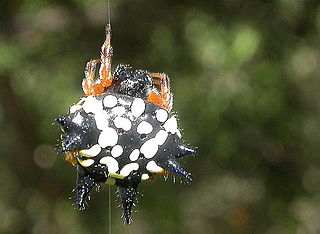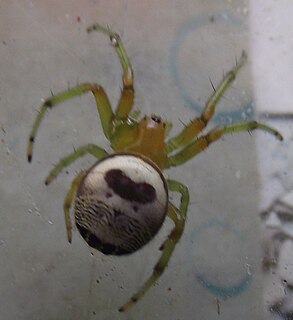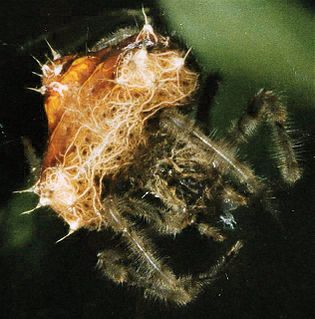
Orb-weaver spiders are members of the spider family Araneidae. They are the most common group of builders of spiral wheel-shaped webs often found in gardens, fields, and forests. The English word orb can mean "circular", hence the English name of the group. Araneids have eight similar eyes, hairy or spiny legs, and no stridulating organs.

Austracantha is a genus of spider with a single species, Austracantha minax, commonly known as the jewel spider or the Christmas spider. It is a member of the family Araneidae and is endemic to Australia. They are relatively small spiders, reaching a maximum total body length of only around 12 mm (0.47 in) for females, and 5 mm (0.20 in) for males. Their abdomen has six distinctive projections ("spines") that makes them easy to identify. They are predominantly a shiny black, with variable white, yellow, and orange patterns. Melanistic forms also occur during autumn. They are facultatively gregarious, and can be found in large aggregations of overlapping orb webs. They feed on small flying insects that get entangled in their webs. They are harmless to humans, though the webs can be a nuisance for bushwalkers. They are most abundant during the summer months.

A bolas spider is a member of the orb-weaver spider that, instead of spinning a typical orb web, hunts by using one or more sticky "capture blobs" on the end of a silk line, known as a "bolas". By swinging the bolas at flying male moths or moth flies nearby, the spider may snag its prey rather like a fisherman snagging a fish on a hook. Because of this, they are also called angling or fishing spiders. The prey is lured to the spider by the production of up to three sex pheromone-analogues.

Zygiella x-notata, sometimes known as the missing sector orb weaver or the silver-sided sector spider, is a spider species in the family Araneidae. They are solitary spiders, residing in daily-spun orb webs. Z. x-notata is a member of the genus Zygiella, the orb-weaving spiders. The adult female is easily recognized by the characteristic leaf-like mark on her posterior opisthosoma, caudal to the yellow-brown cephalothorax.

Metepeira labyrinthea, the labyrinth orbweaver, is a spider, with thin legs and a round, bulbous abdomen It is a member of the genus Metepeira in the family Araneidae. The female’s length is 5.3 mm, its carapace 2.3 mm, abdomen 3.3 mm, and extended legs 18.4 mm. The carapace is brown or gray, and the abdomen is dark with a white pattern. The legs alternate pale brown and dark brown, and the sternum is dark brown with a longitudinal yellow mark. The male spider is three-quarters of the female’s length, or slightly larger, with a darker carapace and with greater contrast between dark and light areas of the legs. Metepeira are easily distinguished from other Araneidae by their light eye region, white median line on the sternum, relative length of the leg segments, small male palpus, weakly sclerotized epigyne and the special composite web.

Argiope catenulata, also known as the grass cross spider, is a species of orb-weaver spiders ranging from India to the Philippines and Papua New Guinea, and also found in Australia in 2019. Like other species of the same genus, it builds a web with a zig-zag stabilimentum.

Araneus mitificus, commonly known as the kidney garden spider or pale orb weaver, is a species of orb-weaver spider found in South, East, and Southeast Asia.
Exechocentrus is a genus of Madagascan orb-weaver spiders first described by Eugène Simon in 1889. It is a bolas-using spider, capturing its prey with one or more sticky drops at the end of a single line of silk rather than in a web.

Pasilobus is a genus of orb-weaver spiders first described by Eugène Simon in 1895.

Larinia jeskovi is a species of the family of orb weaver spiders and a part of the genus Larinia. It is distributed throughout the Americas, Africa, Australia, Europe, and Asia and commonly found in wet climes such as marshes, bogs, and rainforests. Larinia jeskovi have yellow bodies with stripes and range from 5.13-8.70 millimeters in body length. They build their webs on plants with a small height above small bodies of waters or wetlands. After sunset and before sunrise are the typical times they hunt and build their web. Males usually occupy a female's web instead of making their own. The mating behavior is noteworthy as male spiders often mutilate external female genitalia to reduce sperm competition while female spiders resort to sexual cannibalism to counter such mechanisms. The males also follow an elaborate courtship ritual to attract the female. The bite of Larinia jeskovi is not known to be of harm to humans.

Cyrtarachninae is a subfamily of spiders in the family Araneidae. The group has been circumscribed in several different ways. It originated as the group Cyrtarachneae, described by Eugène Simon in 1892. The group was later treated at different ranks: as a tribe, both under Simon's name and as Cyrtarachnini, and as the subfamily Cyrtarachninae. Circumscriptions have varied. The broadest circumscription, Cyrtarachninae sensu lato (s.l.), includes three of Simon's original groups, including the bolas spiders. Unlike most araneids, members of the subfamily do not construct orb webs, some not using webs at all to capture prey, some using one or more sticky drops on a single line, while others construct webs with few widely spaced non-spiral threads, some triangular. Many have been shown to attract prey by producing analogues of insect sex pheromones, particularly to attract male moths. Adult females may mimic snails, bird droppings and other objects, and so are able to remain exposed during the day time, capturing prey at night.
Mastophora extraordinaria is a species of spider in the orb-weaver spider family Araneidae. It is found in South America. Like some other species of the genus Mastophora, adult females resemble bird droppings. Mastophora species, including M. extraordinaria, are "bolas spiders" – adult females capture their prey by using a sticky drop on the end of a single line which they swing at the target, usually a male moth attracted by the release of an analogue of the attractant sex pheromone produced by the female moth. Juveniles and adult males do not use a bolas, catching prey with their legs alone.
Cladomelea akermani is a species of spider in the orb-weaver spider family Araneidae, found in South Africa. Cladomelea species, including C. akermani, are "bolas spiders" – adult females capture their prey by using a sticky drop on the end of a single line which they swing, usually catching male moths attracted by the release of an analogue of the attractant sex pheromone produced by the female moth. Juvenile and adult male bolas spiders do not use a bolas, catching prey with their legs alone.

Cladomelea debeeri is a species of spider in the orb-weaver spider family Araneidae, found in South Africa. It was first described in 2004. Cladomelea species, including C. debeeri, are "bolas spiders" – adult females capture their prey by using one or more sticky drops on the end of a line which they swing, usually catching male moths attracted by the release of an analogue of the attractant sex pheromone produced by the female moth. Juvenile and adult male bolas spiders do not use a bolas, catching prey with their legs alone.

Cyrtarachne nagasakiensis is a species of spider in the orb-weaver spider family Araneidae, found in Pakistan, India, China, Korea and Japan. Spiders in the genus Cyrtarachne construct "spanning-thread webs" rather than the more typical orb webs of the family Araneidae. These webs have a small number of radii and instead of a tight spiral of sticky threads, the sticky spanning threads are widely spaced and do not form a spiral. When prey is caught on one of the spanning threads, one end comes loose, and the prey, often a moth, dangles from the other end until hauled in by the spider.

Cyrtarachne yunoharuensis is a species of spider in the orb-weaver spider family Araneidae, found in China, Korea and Japan. Spiders in the genus Cyrtarachne construct "spanning-thread webs" rather than the more typical orb webs of the family Araneidae. These webs have a small number of radii and instead of a tight spiral of sticky threads, the sticky spanning threads are widely spaced and do not form a spiral. When prey is caught on one of the spanning threads, one end comes loose, and the prey, often a moth, dangles from the other end until hauled in by the spider.
Exechocentrus lancearius is a species of spider in the orb-weaver spider family Araneidae, found only in Madagascar. It was initially described from a partial specimen of an adult female. The first description of a complete specimen and its prey-catching behaviour was published in 2012. E. lancearius is a bolas spider. Rather than using a web, adult females catch their prey by using a line with one or two sticky drops which they swing.
Ordgarius monstrosus is a species of spider in the orb-weaver spider family Araneidae, found in Queensland, Australia. O. monstrosus is a bolas spider. Rather than using a web, adult females catch their prey by using a line with one or two sticky drops which they swing.

Ordgarius sexspinosus is a species of spider in the orb-weaver spider family Araneidae, found from India to Japan and Indonesia. O. monstrosus is a bolas spider. Rather than using a web, adult females catch their prey by using a line with one or two sticky drops which they swing.

Pasilobus hupingensis is a species of spider in the orb-weaver spider family Araneidae, found in China and Japan. Females of the genus Pasilobus construct "spanning-thread webs" with only two sectors, making them appear triangular. Widely spaced threads with sticky drops span the three radii of these webs. One end is attached in such a way that it readily breaks free. When a prey item is caught on one of these threads, the line parts at this end and the prey hangs from the web until it is hauled up by the spider.














